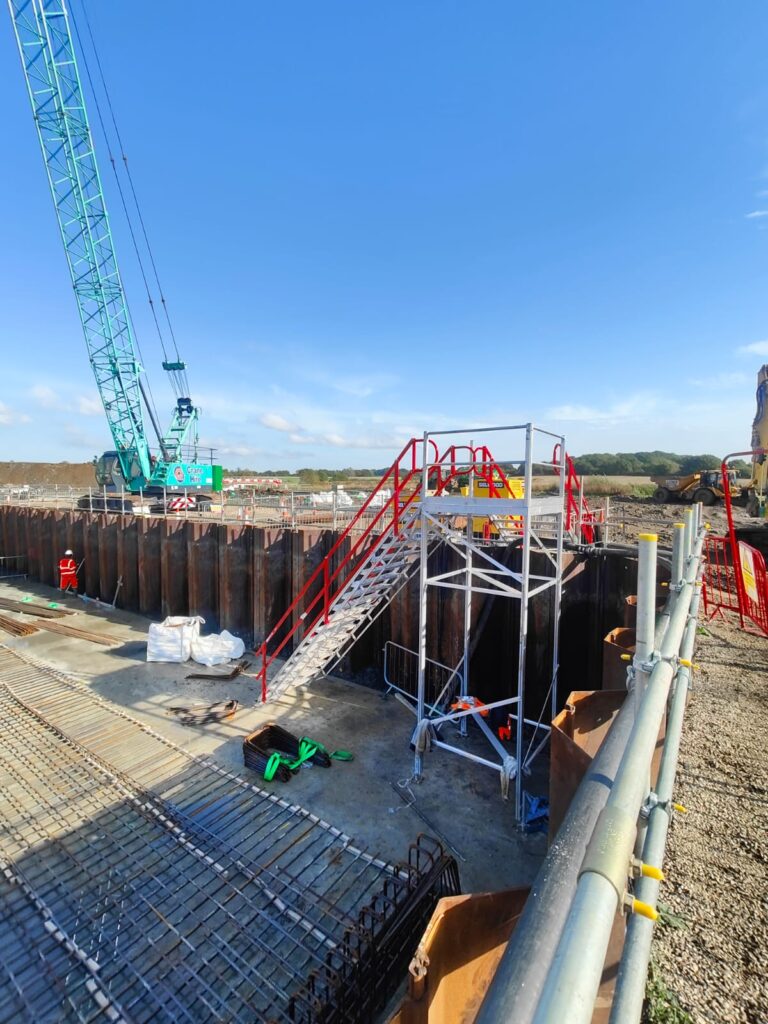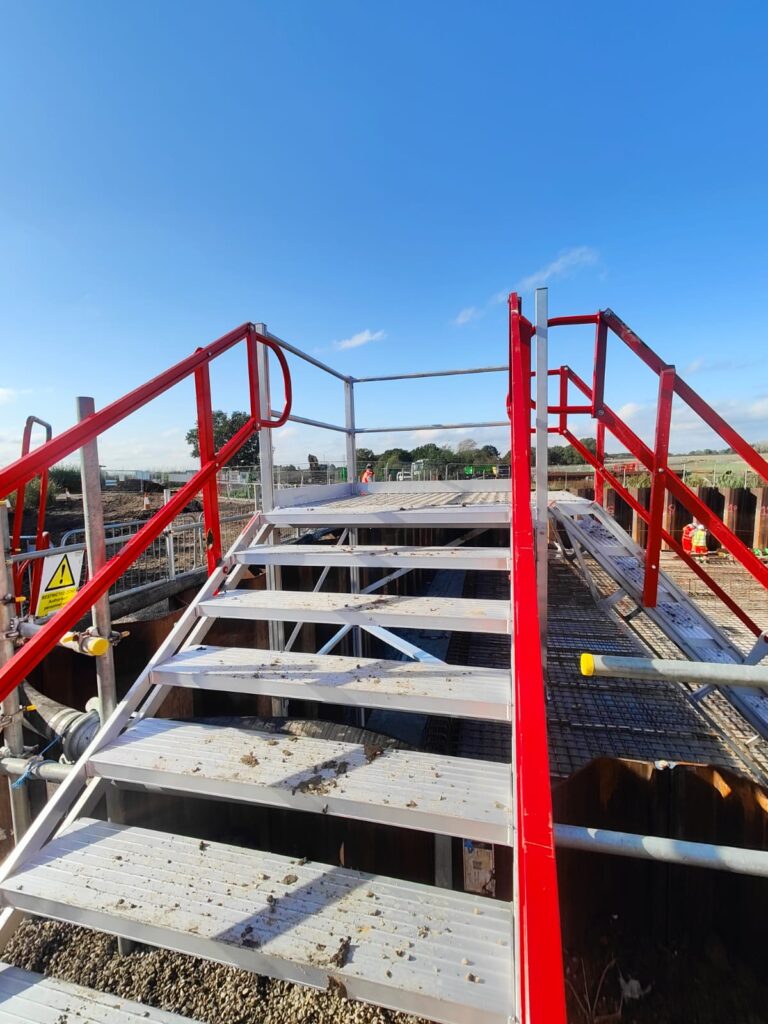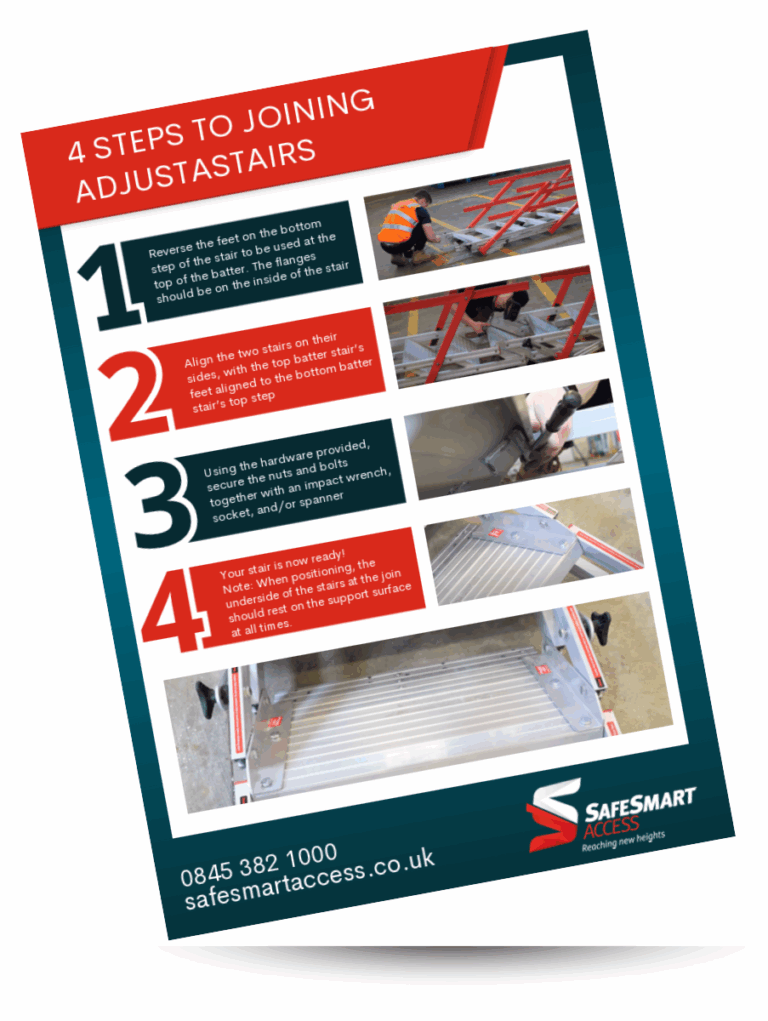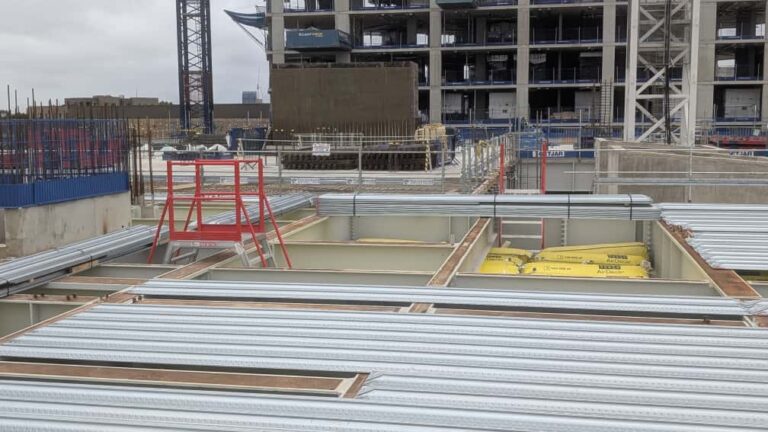The Unique Complexity of Cofferdam Construction Projects
Cofferdam construction is among the most demanding civil engineering tasks, requiring temporary watertight enclosures to allow construction work in dry conditions below the water line. Access solutions for these projects are critically complex due to several factors:
- Dynamic Environments: The internal environment of a cofferdam construction is often subject to changing water levels, muddy conditions, and limited space, demanding robust, non-slip, and quick-to-install equipment.
- Significant Height Differences: Access often requires spanning large, steep vertical drops or rises, necessitating stair systems that are compliant, stable, and capable of handling substantial load and traffic.
- Logistical Constraints: Equipment must be easily manoeuvrable within a constrained space, and any solution must allow for quick adaptation or relocation as the project progresses.
When BAM Nuttall Ltd approached SafeSmart Access with a requirement for secure access into a newly installed cofferdam, they presented a diagram detailing a critical and complex height requirement.
The Challenge : Secure Multi-Level Access
The specific challenge involved establishing compliant access from the full ground level down into the cofferdam construction. The required access path had two distinct phases:
Phase 1: A significant height drop from the main ground level to an intermediate working platform inside the cofferdam. (Implied height range of 1.4m to 2.0m)
Phase 2: A further, steeper descent from this intermediate level down to the lowest accessible working area within the cofferdam base. (Implied height range of 2.7m to 4.1m)
Directional Change: Crucially, the access path needed to change direction at the intermediate level, running down perpendicularly to the first flight.
The Better Way : Double Width AdjustaStairs and Modular Landings
AdjustaStairs Aluminium 1200mm wide (available from 3 – 21 steps)*
The proposed system components were:
Component | Specification | Function in Project |
Mid Landing | AdjustaStairs 4mH Mid Landing | Placed securely inside the cofferdam to serve as the intermediate working platform and directional hub. |
Upper Flight | AdjustaStairs Aluminium 1200mm Wide 9 Step (1.4 – 2.0m Height) inc midrail | Installed running up from the full ground level to the Mid Landing. |
Lower Flight | AdjustaStairs Aluminium 1200mm Wide 18 Step (2.7 – 4.1m Height) inc midrail & truss | Installed running down from the Mid Landing to the base level of the cofferdam, running perpendicular to the upper flight. |
Configuration Details:
The modular 4mH Mid Landing was strategically placed to manage the primary connection point. The 9-step AdjustaStairs, offering adjustability to precisely match the upper ground level to the landing height, provided the initial secure descent. The 18-step AdjustaStairs then locked securely into the landing structure, providing a safe, compliant, and adjustable staircase for the final descent. The ability of the stairs to adjust their pitch and height within a specified range was critical for ensuring a perfect fit between the varying levels of the site and the fixed landing.
How To Install AdjustaStairs : 7 Quick Steps (Easy Assembly)
- Remove the packaging and lay the stair flat.
- Place the stair on the support surface with the top step facing the fixing location.
- Open the stair treads by twisting steps, to minimum of 30-degrees.
- Lift the handrails until the locator-tab can be slipped over the bolt, and tighten the wing-nut firmly.
- Secure the locking tab position by tightening the lock tab knob.
- Fix the top step onto the support rail, floor, or beam.
For timber, use a hex washer type 17 (14 gauge) x 50mm screw to secure it into a timber base.
For concrete, Use a 10 x 50mm concrete anchor screw. The concrete must be a minimum of 25MPa.
Where possible, fix the foot of the stair onto the lower support surface
⏱️ Average time: 18 min, two operatives, zero power tools.
Outcome and Benefits
By utilizing the modular AdjustaStairs system, SafeSmart Access provided BAM Nuttall Ltd with a swift, compliant, and easily assembled solution tailored precisely to the confined and challenging environment of the cofferdam.
The system delivered:
- Compliant Access: Ensuring workers could transit the significant height changes safely and securely, meeting all working-at-height regulations.
- Rapid Installation: The modular nature of AdjustaStairs reduced site erection time compared to traditional scaffold or custom fabrication.
- Built-in Safety: Midrails and the inherent stability of the trussed, aluminium design provided immediate fall protection.
- Adaptability: Should site levels or project phases change, the AdjustaStairs can be quickly repositioned or adjusted to a different height within their range, protecting the client’s investment in access equipment.
This project exemplifies how SafeSmart Access combines robust, engineered access products with expert consultation to overcome the most demanding logistical and safety challenges inherent in complex civil construction, such as cofferdams.
Ready to enhance your workplace safety? Explore SafeSmart’s comprehensive range of work platforms including the industry-leading SafeLoader, Work Platforms, Bridges and Temporary Stairs systems, designed specifically for UK commercial applications. Call us on +44 (0)845 382 1000 or email [email protected]
Temporary Staircase FAQ’s
Yes, please get in touch with our sales team in order to find out more.
Yes—2.0 kN/m² loading covers crews, tools and inspectors.
Yes — we offer both 600mm and 1200mm wide AdjustaStairs. The 1200mm option is specifically designed for emergency stretcher access and allows for two-way foot traffic at all times, making it ideal for high-activity worksites or where rapid evacuation is a consideration.
Guard with fire blankets where hot works cross the work area.
Visual check weekly; full strip inspection every six months.
Yes unless the stair abuts a wall; then guard the unprotected side only.
- Direction of travel on a ladder is near‑vertical, increasing fatigue.
- Only one worker moves at a time—delays multiply over weeks.
- In slippery conditions, the accident rate is 4× higher than on stairs.








